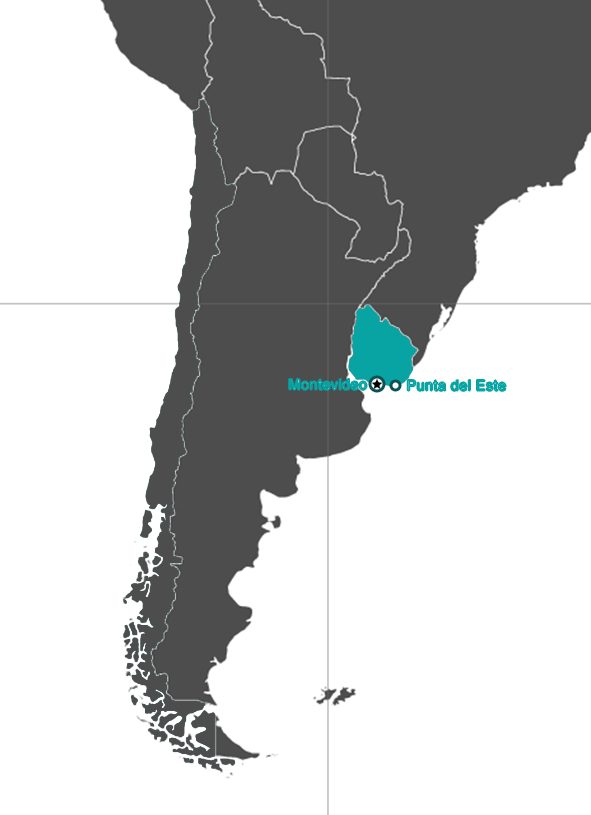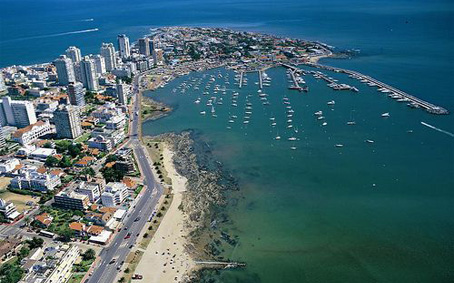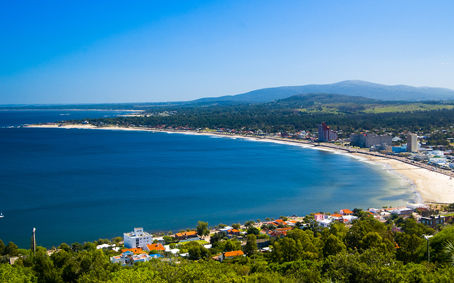Uruguay . Punta del este
Passports: Uruguay requires passports of all foreigners, except those from neighboring countries (who need only national identification cards).
Customs Regulations: Uruguay has no unusual customs restrictions; travelers arriving from overseas may bring in up to four cartons of cigarettes and 4L of alcohol, along with consumer electronics for personal use such as cell phones, laptops, cameras and/or video equipment. Pets must be accompanied by a health certificate from their home country. Restricted items include vegetables, fruits, seeds, flowers, soil, fresh dairy products, meat products and animal feed.
Visas: not required for nationals of Western Europe, Australia, USA, Canada or New Zealand: they automatically receive a 90-day tourist card, renewable for another 90 days. Other nationals may require visas.
Electricity: Uruguay’s electric current operates on 220V; 50Hz; plugs are C / F / I / L type. Adapters are readily available from almost any ferretería (hardware store). Most electronic equipment (such as cameras, telephones and computers) are dual/multi-voltage, but some equipment may require a voltage converter or you might short out your device.
Time: Uruguay Standard Time is three hours behind GMT, as in Argentina. Daylight-saving time was abolished in 2015.
Internet Access: Wi-Fi zones are commonplace in cities and larger towns. Antel (state telephone company) offices sell SIM cards with reasonably priced data plans for unlocked phones, and also provide free Wi-Fi in many cases.
Telephone: Uruguay’s country code is 598. Antel (www.antel.com.uy) is the state telephone company, with offices in every town. All Uruguayan landline numbers are eight digits long, beginning with 2 for Montevideo or 4 for elsewhere in the country. Cell (mobile) phone numbers consist of a three-digit prefix (most commonly 099) followed by a six-digit number. If dialing internationally, drop the leading zero.
Mobile Phones: three companies –Antel (www.antel.com.uy), Claro (www.claro.com.uy) and Movistar (www.movistar.com.uy)– provide cell-phone service in Uruguay. Rather than use expensive roaming plans, many travelers bring an unlocked cell phone (or buy a cheap one here) and insert a local pay-as-you-go SIM card. SIMs can readily be purchased at Antel offices and recharged at service stations, shopping malls and street side kiosks throughout Uruguay.
ATMs: in all but the smallest interior towns, getting cash with your ATM card is easy. Machines marked with the green Banred or blue Redbrou logos serve all major international banking networks. ATMs dispense bills in multiples of 100 pesos. Many also dispense US dollars, designated as US$, but only in multiples of US$100.
Credit Cards: most up market hotels, restaurants and shops accept credit cards. Visa is most commonly accepted, followed by MasterCard. American Express cards are of more limited use.
Currency: prices are in Uruguayan pesos (UR$), the official Uruguayan currency. Banknote values are 20, 50, 100, 200, 500, 1000 and 2000. There are coins of one, two, five, 10 and 50 pesos. US dollars are commonly accepted in major tourist hubs, where many accommodations quote US$ prices. In hotels that accept payment in either dollars or pesos, it pays to check the exchange rate offered. Away from the touristic areas, dollars are of limited use. Uruguay has no black or 'blue' market offering higher exchange rates for US and European banknotes, as happens in Argentina.
Money Changers: there are “casas de cambio” in Montevideo, Colonia, the Atlantic beach resorts and border towns such as Chuy. They typically keep longer hours than banks but may offer lower rates.
Tipping: in Restaurants leave 10% of the bill. Taxis, round up the fare a few pesos.
Taxes & Refunds: hotel rooms in Uruguay are automatically tax-free for foreigners. In addition, travelers using a foreign credit or debit card to pay for rental cars and restaurant meals receive an instant VAT rebate, which essentially translates to a 22% discount. Other large purchases of items to be taken out of Uruguay may also qualify for a VAT refund, but you'll need to request a claim form at the time of purchase and submit your refund request at the port or airport where you leave the country.
Opening Hours
Banks 1–7pm Monday to Friday
Bars, pubs and clubs 6pm–late
Restaurants noon until midnight or later; if serving breakfast, open around 8am
Shops 9am–1pm and 3–7pm Monday to Saturday; in larger cities, many stay open at lunchtime and/or on Sunday
Smoking: it is not allowed in public spaces, including restaurants, cinemas, theaters and public transport.
Uruguay may be pint-sized but it's certainly big-hearted when it comes to attractions. It contains one of South America's most interesting capitals, charming colonial towns and a cluster of internationally renowned beach resorts. Uruguay -the smallest Hispanic country in South America- is boxed into the eastern coast of South America by Brazil to the north and Argentina to the west. To the south is the wide estuary of the Río de la Plata, while the Atlantic Ocean washes its eastern shore. For the most part, the country's undulating topography is an extension of that in southern Brazil, and includes two lowly ranges - the Cuchilla de Haedo and the Cuchilla Grande. The terrain levels out west of Montevideo, while east of the capital there are impressive beaches, dunes and headlands. Five rivers flow westward across the country and drain into the Uruguay River. The country's flora consists mostly of grasslands, with little forest except on the banks of its rivers and streams. In the southeast, along the Brazilian border, are lingering traces of palm savannah. Wild animals are scarce, although rhea (a bird-like ostrich) can still be seen in areas near major tributaries. The climate is temperate, even in winter, and frosts are almost unknown. Winter (June to September) temperatures range from 10 to 16ºC (50 to 61ºF), while summer (December to March) temperatures lie between 21 to 28ºC (70 to 82ºF). Rainfall, evenly distributed throughout the year, averages about 1m (3ft) over the entire country. Uruguay's main attraction is its beaches, so most visitors come in summer. Along the littoral, summer temperatures are smotheringly hot, but the hilly interior is cooler, particularly at nightspecially at night.
Population: 3,4 million.
Capital city: Montevideo.
People: 88% European descent, 8% Mestizo, 4% Black. Language: Spanish.
Religion: 66% roman catholic, 2% protestant, 2% jewish.


